Tannin Industry Waste-Derived Porous Carbon: An Effective Adsorbent from Black Wattle Bark for Organic Pollutant Removal
Abstract
1. Introduction
2. Material and Methods
2.1. Experimental Design for the Synthesis of Carbonaceous Material
2.2. Characterization Procedures
2.2.1. X-ray Diffraction (XRD)
2.2.2. Scanning Electron Microscopy (SEM)
2.2.3. Brunauer-Emmett-Teller (BET) and Barrett-Joyner-Halenda (BJH) Analyses
2.2.4. Fourier-Transform Infrared Spectroscopy (FTIR)
2.2.5. Raman Spectroscopy
2.2.6. Electron Paramagnetic Resonance (EPR)
2.3. Application of the Activated Biochar
3. Results and Discussion
3.1. Pyrolysis Process and Evaluation of ZnCl2 Doping by XRD
3.2. Effects of Primary Factors and Second-Order Interactions on Mass Yield
3.3. Characterization of the Samples
3.3.1. SEM
3.3.2. BET and BJH Analyses
3.3.3. FTIR Analyses
3.3.4. Raman Spectroscopy Analyses
3.3.5. EPR Spectroscopy
3.4. Application of Biochar
4. Conclusions
Supplementary Materials
Author Contributions
Funding
Institutional Review Board Statement
Informed Consent Statement
Data Availability Statement
Conflicts of Interest
References
- IBGE Production of Siviculture and Vegetal Extraction. Available online: https://cidades.ibge.gov.br/brasil/pesquisa/16/12705 (accessed on 29 May 2023).
- Doumer, M.E.; Arízaga, G.G.C.; da Silva, D.A.; Yamamoto, C.I.; Novotny, E.H.; Santos, J.M.; dos Santos, L.O.; Wisniewski, A., Jr.; de Andrade, J.B.; Mangrich, A.S. Slow Pyrolysis of Different Brazilian Waste Biomasses as Sources of Soil Conditioners and Energy, and for Environmental Protection. J. Anal. Appl. Pyrolysis 2015, 113, 434–443. [Google Scholar] [CrossRef]
- Ferreira-Leitão, V.; Gottschalk, L.M.F.M.F.; Ferrara, M.A.A.; Nepomuceno, A.L.L.; Molinari, H.B.C.B.C.; Bon, E.P.S.P.S.; Ferreira-Leitao, V.; Gottschalk, L.M.F.M.F.; Ferrara, M.A.A.; Nepomuceno, A.L.L.; et al. Biomass Residues in Brazil: Availability and Potential Uses. Waste Biomass Valorization 2010, 1, 65–76. [Google Scholar] [CrossRef]
- Nair, L.G.; Agrawal, K.; Verma, P. An Overview of Sustainable Approaches for Bioenergy Production from Agro-Industrial Wastes. Energy Nexus 2022, 6, 100086. [Google Scholar] [CrossRef]
- Amalina, F.; Razak, A.S.A.; Krishnan, S.; Sulaiman, H.; Zularisam, A.W.; Nasrullah, M. Biochar Production Techniques Utilizing Biomass Waste-Derived Materials and Environmental Applications—A Review. J. Hazard. Mater. Adv. 2022, 7, 100134. [Google Scholar] [CrossRef]
- Schultz, J.; Capobianco, G.; da Silva Veiga, P.A.; Fornari, M.R.; Antonangelo, A.R.; Tebcherani, S.M.; Mangrich, A.S.; Pianaro, S.A. Sustainable Activated Carbon Obtained as a By-Product of the Sugar and Alcohol Industry for Removal of Amoxicillin from Aqueous Solution. Energy Ecol. Environ. 2020, 5, 433–443. [Google Scholar] [CrossRef]
- da Silva Veiga, P.A.; Cerqueira, M.H.; Goncalves, M.G.; da Silva Matos, T.T.; Pantano, G.; Schultz, J.; de Andrade, J.B.; Mangrich, A.S. Upgrading from Batch to Continuous Flow Process for the Pyrolysis of Sugarcane Bagasse: Structural Characterization of the Biochars Produced. J. Environ. Manag. 2021, 285, 112145. [Google Scholar] [CrossRef] [PubMed]
- Wang, H.; Nan, Q.; Waqas, M.; Wu, W. Stability of Biochar in Mineral Soils: Assessment Methods, Influencing Factors and Potential Problems. Sci. Total Environ. 2022, 806, 150789. [Google Scholar] [CrossRef]
- Díaz-Maroto, C.G.; Mašek, O.; Pizarro, P.; Serrano, D.P.; Moreno, I.; Fermoso, J. Removal of NO at Low Concentrations from Polluted Air in Semi-Closed Environments by Activated Biochars from Renewables Feedstocks. J. Environ. Manag. 2023, 341, 118031. [Google Scholar] [CrossRef]
- El-Bestawy, E.A.; Gaber, M.; Shokry, H.; Samy, M. Effective Degradation of Atrazine by Spinach-Derived Biochar via Persulfate Activation System: Process Optimization, Mechanism, Degradation Pathway and Application in Real Wastewater. Environ. Res. 2023, 229, 115987. [Google Scholar] [CrossRef]
- Piloni, R.V.; Fontes Coelho, L.; Sass, D.C.; Lanteri, M.; Zaghete Bertochi, M.A.; Laura Moyano, E.; Contiero, J. Biochars from Spirulina as an Alternative Material in the Purification of Lactic Acid from a Fermentation Broth. Curr. Res. Green Sustain. Chem. 2021, 4, 100084. [Google Scholar] [CrossRef]
- Bhavani, P.; Hussain, M.; Park, Y.-K. Recent Advancements on the Sustainable Biochar Based Semiconducting Materials for Photocatalytic Applications: A State of the Art Review. J. Clean. Prod. 2022, 330, 129899. [Google Scholar] [CrossRef]
- Cha, J.S.; Park, S.H.; Jung, S.-C.; Ryu, C.; Jeon, J.-K.; Shin, M.-C.; Park, Y.-K. Production and Utilization of Biochar: A Review. J. Ind. Eng. Chem. 2016, 40, 1–15. [Google Scholar] [CrossRef]
- Yaashikaa, P.R.; Senthil Kumar, P.; Varjani, S.J.; Saravanan, A. Advances in Production and Application of Biochar from Lignocellulosic Feedstocks for Remediation of Environmental Pollutants. Bioresour. Technol. 2019, 292, 122030. [Google Scholar] [CrossRef]
- Demiral, H.; Demiral, İ.; Tümsek, F.; Karabacakoğlu, B. Pore Structure of Activated Carbon Prepared from Hazelnut Bagasse by Chemical Activation. Surf. Interface Anal. 2008, 40, 616–619. [Google Scholar] [CrossRef]
- Kılıç, M.; Apaydın-Varol, E.; Pütün, A.E. Preparation and Surface Characterization of Activated Carbons from Euphorbia Rigida by Chemical Activation with ZnCl2, K2CO3, NaOH and H3PO4. Appl. Surf. Sci. 2012, 261, 247–254. [Google Scholar] [CrossRef]
- Heidarinejad, Z.; Dehghani, M.H.; Heidari, M.; Javedan, G.; Ali, I.; Sillanpää, M. Methods for Preparation and Activation of Activated Carbon: A Review. Environ. Chem. Lett. 2020, 18, 393–415. [Google Scholar] [CrossRef]
- Yang, K.; Peng, J.; Srinivasakannan, C.; Zhang, L.; Xia, H.; Duan, X. Preparation of High Surface Area Activated Carbon from Coconut Shells Using Microwave Heating. Bioresour. Technol. 2010, 101, 6163–6169. [Google Scholar] [CrossRef]
- de Moraes, N.P.; Boldrin, F.H.C.; Campos, T.M.B.; Thim, G.P.; Lianqing, Y.; de Vasconcelos Lanza, M.R.; Rodrigues, L.A. Black-Wattle Tannin/Kraft Lignin H3PO4-Activated Carbon Xerogels as Excellent and Sustainable Adsorbents. Int. J. Biol. Macromol. 2023, 227, 58–70. [Google Scholar] [CrossRef] [PubMed]
- de Azevedo, C.F.; Rodrigues, D.L.C.; Silveira, L.L.; Lima, E.C.; Osorio, A.G.; Andreazza, R.; de Pereira, C.M.P.; Poletti, T.; Machado Machado, F. Comprehensive Adsorption and Spectroscopic Studies on the Interaction of Magnetic Biochar from Black Wattle Sawdust with Beta-Blocker Metoprolol. Bioresour. Technol. 2023, 388, 129708. [Google Scholar] [CrossRef] [PubMed]
- Beckinghausen, A.; Reynders, J.; Merckel, R.; Wu, Y.W.; Marais, H.; Schwede, S. Post-Pyrolysis Treatments of Biochars from Sewage Sludge and A. Mearnsii for Ammonia (NH4-n) Recovery. Appl. Energy 2020, 271, 115212. [Google Scholar] [CrossRef]
- Lütke, S.F.; Igansi, A.V.; Pegoraro, L.; Dotto, G.L.; Pinto, L.A.A.; Cadaval, T.R.S. Preparation of Activated Carbon from Black Wattle Bark Waste and Its Application for Phenol Adsorption. J. Environ. Chem. Eng. 2019, 7, 103396. [Google Scholar] [CrossRef]
- de Liz, M.V.; Nagata, N.; Peralta-Zamora, P. Considerações Sobre o Preparo de Amostras Contendo Micropoluentes Estrogênicos. Quim. Nova 2012, 35, 1213–1215. [Google Scholar] [CrossRef]
- Ahmadpour, A.; Do, D.D. The Preparation of Activated Carbon from Macadamia Nutshell by Chemical Activation. Carbon N. Y. 1997, 35, 1723–1732. [Google Scholar] [CrossRef]
- Almansa, C.; Molina-Sabio, M.; Rodríguez-Reinoso, F. Adsorption of Methane into ZnCl2-Activated Carbon Derived Discs. Microporous Mesoporous Mater. 2004, 76, 185–191. [Google Scholar] [CrossRef]
- Cherik, D.; Louhab, K. Preparation of Microporous Activated Carbon from Date Stones by Chemical Activation Using Zinc Chloride. Energy Sources Part A Recover. Util. Environ. Eff. 2017, 39, 1935–1941. [Google Scholar] [CrossRef]
- Foo, P.; Lee, L. Preparation of Activated Carbon from Parkia Speciosa Pod by Chemical Activation. In Proceedings of the World Congress on Engineering 2010, London, UK, 30 June–2 July 2010; Volume II, pp. 1–17. [Google Scholar]
- Basu, P. Pyrolysis. In Biomass Gasification, Pyrolysis and Torrefaction; Elsevier Inc.: Amsterdam, The Netherlands, 2013; pp. 147–176. ISBN 978-0-12-396488-5. [Google Scholar]
- Ozhan, A.; Sahin, O.; Kuçuk, M.M.; Saka, C. Preparation and Characterization of Activated Carbon from Pine Cone by Microwave-Induced ZnCl2 Activation and Its Effects on the Adsorption of Methylene Blue. Cellulose 2014, 21, 2457–2467. [Google Scholar] [CrossRef]
- Onal, Y.; Akmil-Başar, C.; Sarici-Ozdemir, Ç.; Erdoğan, S. Textural Development of Sugar Beet Bagasse Activated with ZnCl2. J. Hazard. Mater. 2007, 142, 138–143. [Google Scholar] [CrossRef] [PubMed]
- Ahmed, M.J.; Theydan, S.K. Physical and Chemical Characteristics of Activated Carbon Prepared by Pyrolysis of Chemically Treated Date Stones and Its Ability to Adsorb Organics. Powder Technol. 2012, 229, 237–245. [Google Scholar] [CrossRef]
- Sayğılı, H.; Güzel, F. Performance of New Mesoporous Carbon Sorbent Prepared from Grape Industrial Processing Wastes for Malachite Green and Congo Red Removal. Chem. Eng. Res. Des. 2015, 100, 27–38. [Google Scholar] [CrossRef]
- Dural, M.U.; Cavas, L.; Papageorgiou, S.K.; Katsaros, F.K. Methylene Blue Adsorption on Activated Carbon Prepared from Posidonia oceanica (L.) Dead Leaves: Kinetics and Equilibrium Studies. Chem. Eng. J. 2011, 168, 77–85. [Google Scholar] [CrossRef]
- Saka, C. BET, TG–DTG, FT-IR, SEM, Iodine Number Analysis and Preparation of Activated Carbon from Acorn Shell by Chemical Activation with ZnCl2. J. Anal. Appl. Pyrolysis 2012, 95, 21–24. [Google Scholar] [CrossRef]
- da Costa Lopes, A.S.; de Carvalho, S.M.L.; Brasil, D.D.S.B.; de Alcântara Mendes, R.; Lima, M.O. Surface Modification of Commercial Activated Carbon (CAG) for the Adsorption of Benzene and Toluene. Am. J. Anal. Chem. 2015, 6, 528–538. [Google Scholar] [CrossRef]
- Saleem, J.; Shahid, U.B.; Hijab, M.; Mackey, H.; McKay, G. Production and Applications of Activated Carbons as Adsorbents from Olive Stones. Biomass Convers. Biorefinery 2019, 9, 775–802. [Google Scholar] [CrossRef]
- Lu, X.; Jaroniec, M.; Madey, R. Use of Adsorption Isotherms of Light Normal Alkanes for Characterizing Microporous Activated Carbons. Langmuir 1991, 7, 173–177. [Google Scholar] [CrossRef]
- Moreno-Piraján, J.C.; Giraldo, L. Adsorption of Copper from Aqueous Solution by Activated Carbons Obtained by Pyrolysis of Cassava Peel. J. Anal. Appl. Pyrolysis 2010, 87, 188–193. [Google Scholar] [CrossRef]
- Mahamad, M.N.; Zaini, M.A.A.; Zakaria, Z.A. Preparation and Characterization of Activated Carbon from Pineapple Waste Biomass for Dye Removal. Int. Biodeterior. Biodegrad. 2015, 102, 274–280. [Google Scholar] [CrossRef]
- Rovani, S.; Censi, M.T.; Pedrotti, S.L.; Lima, É.C.; Cataluña, R.; Fernandes, A.N. Development of a New Adsorbent from Agro-Industrial Waste and Its Potential Use in Endocrine Disruptor Compound Removal. J. Hazard. Mater. 2014, 271, 311–320. [Google Scholar] [CrossRef] [PubMed]
- Liao, W.; Zhang, X.; Ke, S.; Shao, J.; Yang, H.; Zhang, S.; Chen, H. The Influence of Biomass Species and Pyrolysis Temperature on Carbon-Retention Ability and Heavy Metal Adsorption Property during Biochar Aging. Fuel Process. Technol. 2023, 240, 107580. [Google Scholar] [CrossRef]
- Matos, T.; Schultz, J.; Khan, M.; Zanoelo, E.; Mangrich, A.; Araújo, B.; Navickiene, S.; Romão, L. Using Magnetized (Fe3O4/Biochar Nanocomposites) and Activated Biochar as Adsorbents to Remove Two Neuro-Active Pesticides from Waters. J. Braz. Chem. Soc. 2017, 28, 1975–1987. [Google Scholar] [CrossRef]
- Liu, Y.; Liao, C.; Tang, Y.; Tang, J.; Sun, Y.; Ma, X. Techno-Environmental-Economic Evaluation of the Small-Scale Municipal Solid Waste (MSW) Gasification-Based and Incineration-Based Power Generation Plants. J. Taiwan Inst. Chem. Eng. 2022, 141, 104594. [Google Scholar] [CrossRef]
- Corrales, R.C.N.R.; Mendes, F.M.T.; Perrone, C.C.; Sant’anna, C.; de Souza, W.; Abud, Y.; Bon, E.P.D.S.; Ferreira-Leitão, V. Structural Evaluation of Sugar Cane Bagasse Steam Pretreated in the Presence of CO2 and SO2. Biotechnol. Biofuels 2012, 5, 36. [Google Scholar] [CrossRef]
- Irfan, M.; Syed, Q.; Sher, M.G.; Baig, S.; Nadeem, M. FTIR and SEM Analysis of Thermo-Chemical Fractionated Sugarcane Bagasse. Turk. J. Biochem. 2011, 36, 322–328. [Google Scholar]
- Geçgel, Ü.; Kocabıyık, B.; Üner, O. Adsorptive Removal of Methylene Blue from Aqueous Solution by the Activated Carbon Obtained from the Fruit of Catalpa Bignonioides. Water Air Soil Pollut. 2015, 226, 1–14. [Google Scholar] [CrossRef]
- Ceyhan, A.A.; Şahin, Ö.; Baytar, O.; Saka, C. Surface and Porous Characterization of Activated Carbon Prepared from Pyrolysis of Biomass by Two-Stage Procedure at Low Activation Temperature and It’s the Adsorption of Iodine. J. Anal. Appl. Pyrolysis 2013, 104, 378–383. [Google Scholar] [CrossRef]
- Ceyhan, A.A.; Şahin, Ö.; Saka, C.; Yalçın, A. A Novel Thermal Process for Activated Carbon Production from the Vetch Biomass with Air at Low Temperature by Two-Stage Procedure. J. Anal. Appl. Pyrolysis 2013, 104, 170–175. [Google Scholar] [CrossRef]
- Dehkhoda, A.M.; Ellis, N.; Gyenge, E. Effect of Activated Biochar Porous Structure on the Capacitive Deionization of NaCl and ZnCl2 Solutions. Microporous Mesoporous Mater. 2016, 224, 217–228. [Google Scholar] [CrossRef]
- Asadullah, M.; Asaduzzaman, M.; Kabir, M.S.; Mostofa, M.G.; Miyazawa, T. Chemical and Structural Evaluation of Activated Carbon Prepared from Jute Sticks for Brilliant Green Dye Removal from Aqueous Solution. J. Hazard. Mater. 2010, 174, 437–443. [Google Scholar] [CrossRef]
- Sheng, C. Char Structure Characterised by Raman Spectroscopy and Its Correlations with Combustion Reactivity. Fuel 2007, 86, 2316–2324. [Google Scholar] [CrossRef]
- Boyera, S.J.; Clarksonb, R.B. Electron Paramagnetic Resonance Studies of an Active Carbon: The Influence of Preparation Procedure on the Oxygen Response of the Linewidth. Colloids Surf. A Physicochem. Eng. Asp. 1994, 82, 217–224. [Google Scholar] [CrossRef]
- Weil, J.; Bolton, J. Electron Paramagnetic Resonance: Elementary Theory and Practical Applications, 2nd ed.; John Wiley & Sons, Inc.: Hoboken, NJ, USA, 2007; ISBN 9780471754961. [Google Scholar]
- Krzesińska, M.; Pilawa, B.; Pusz, S.; Ng, J. Physical Characteristics of Carbon Materials Derived from Pyrolysed Vascular Plants. Biomass Bioenergy 2006, 30, 166–176. [Google Scholar] [CrossRef]
- dos Santos, J.V.; Mangrich, A.S.; Pereira, B.F.; Pillon, C.N.; Novotny, E.H.; Bonagamba, T.J.; Abbt-Braun, G.; Frimmel, F.H. 13C NMR and EPR Spectroscopic Evaluation of Oil Shale Mined Soil Recuperation. J. Braz. Chem. Soc. 2013, 24, 320–326. [Google Scholar] [CrossRef]
- Łoś, S.; Duclaux, L.; Kempiński, W.; Połomska, M. Size Effect in the Characterization of Microporous Activated Nanostructured Carbon. Microporous Mesoporous Mater. 2010, 130, 21–25. [Google Scholar] [CrossRef]
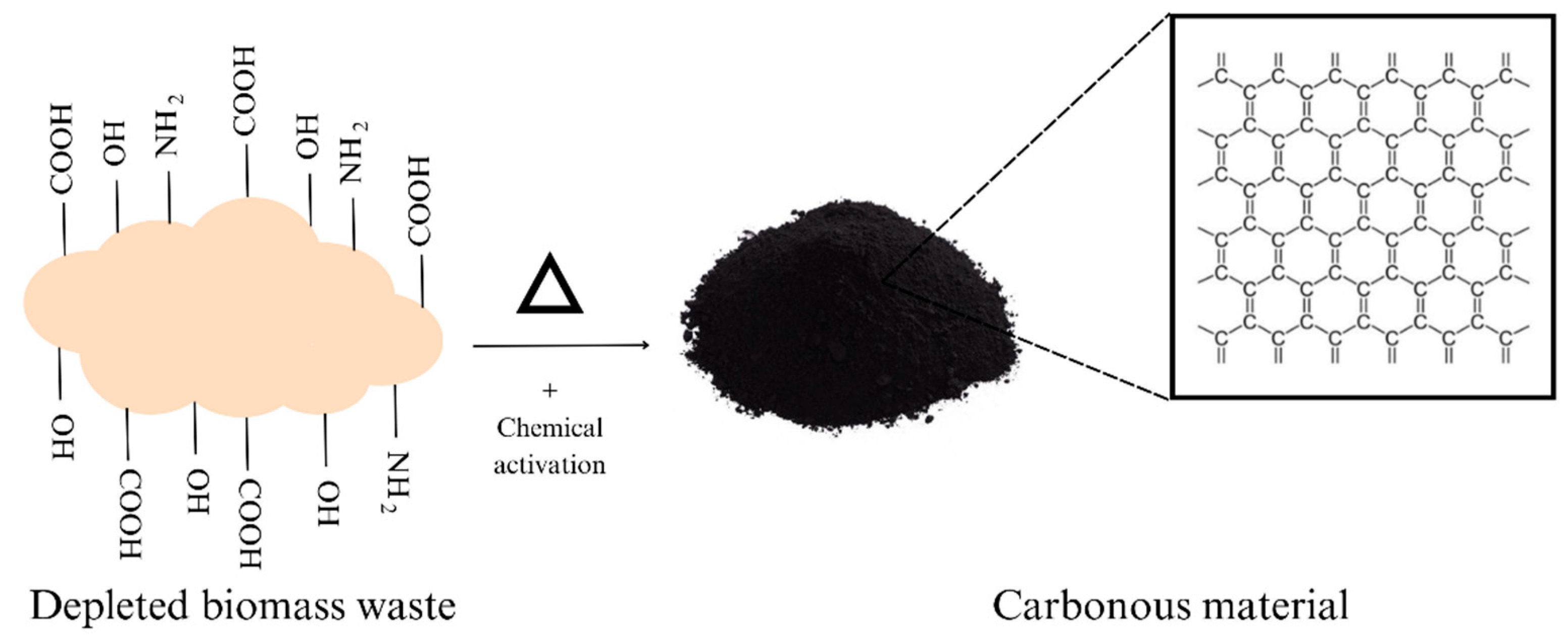
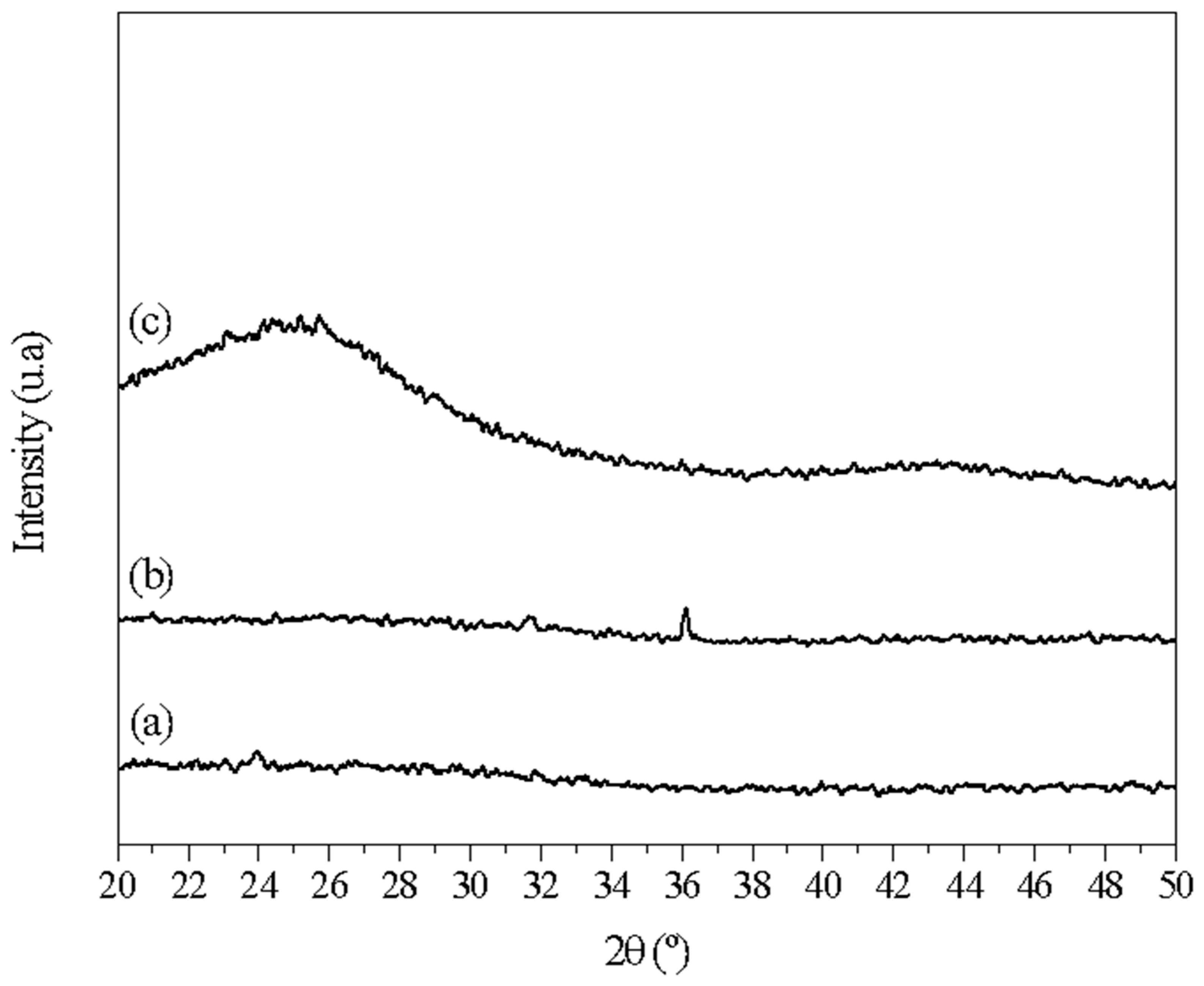

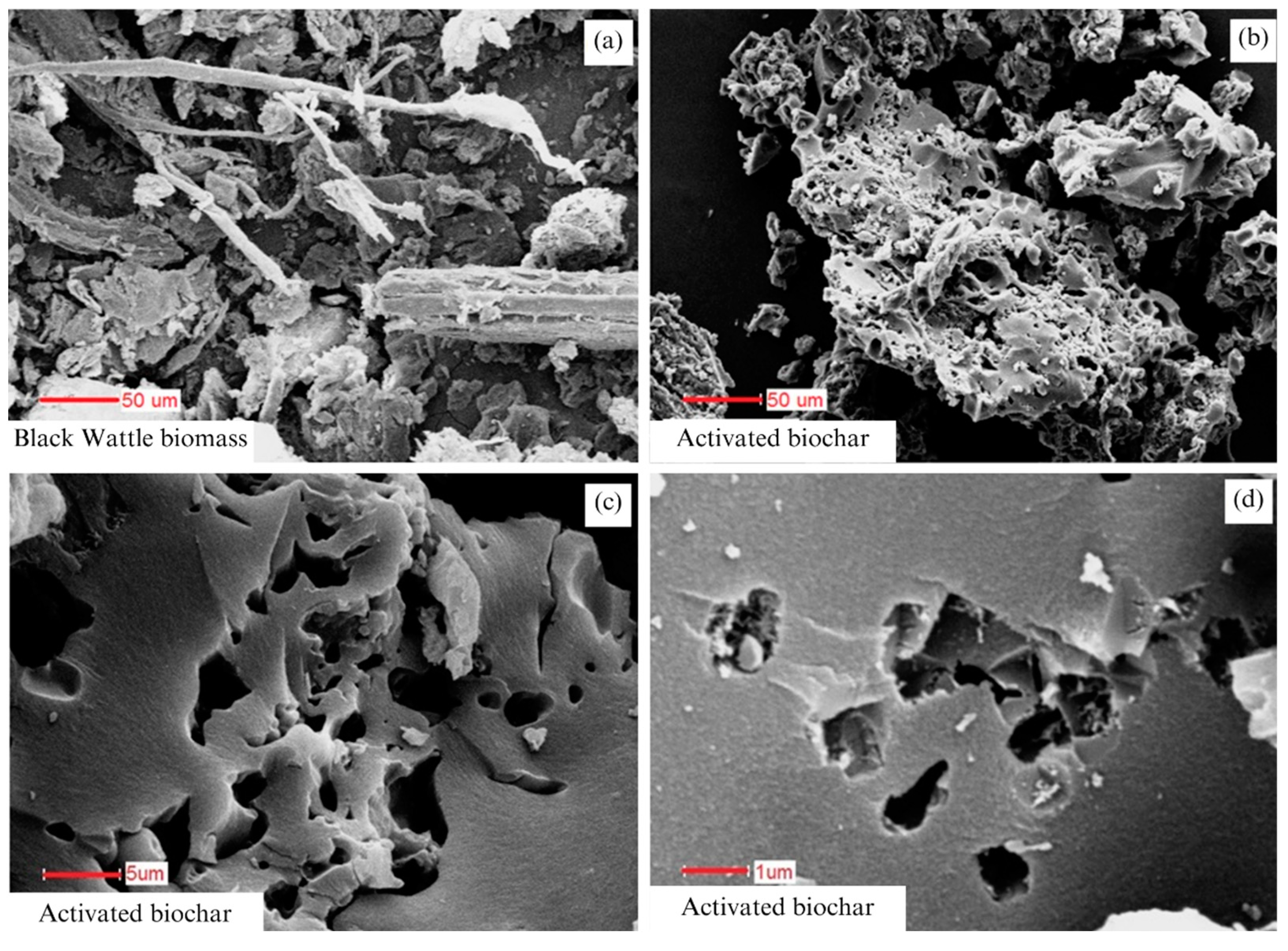
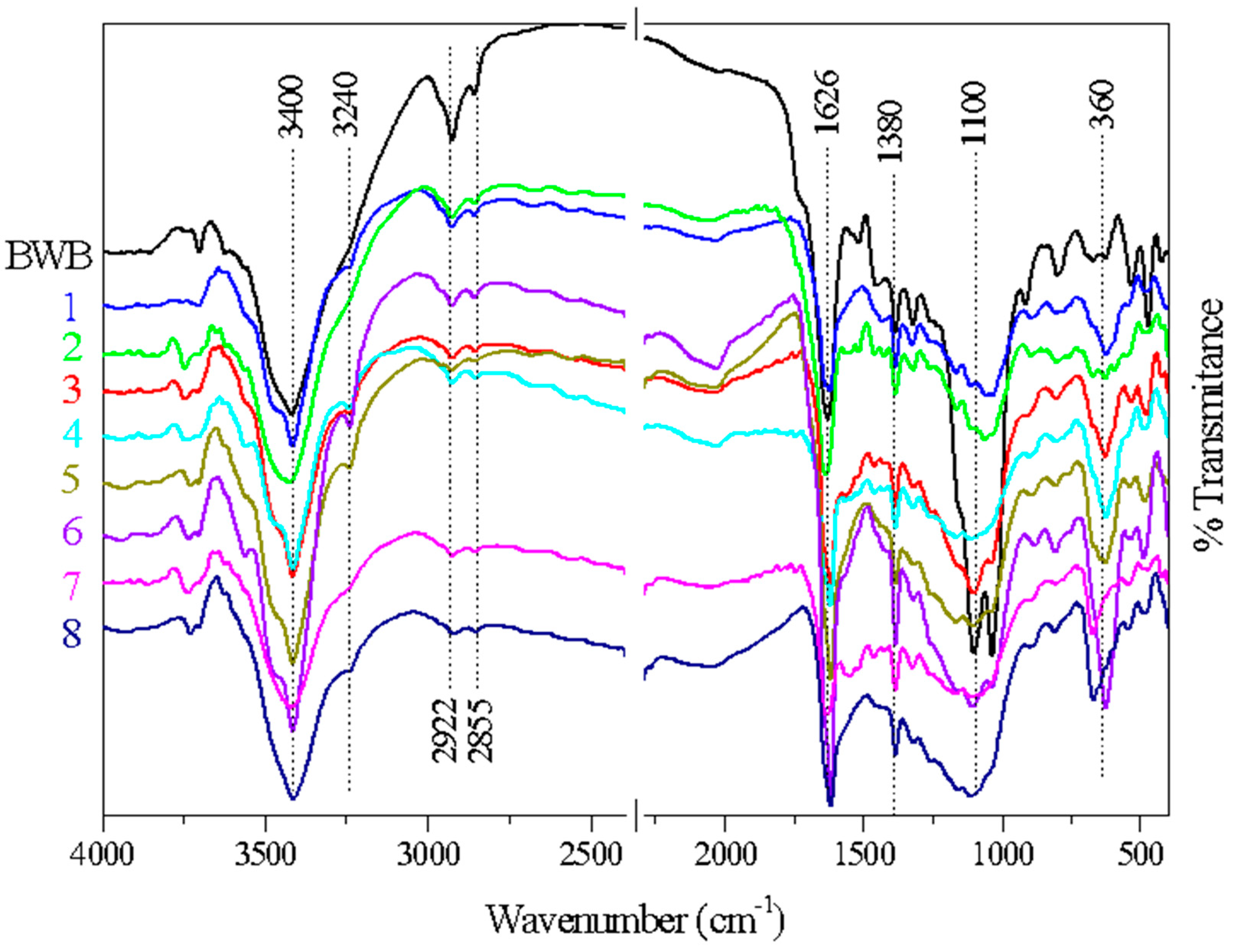

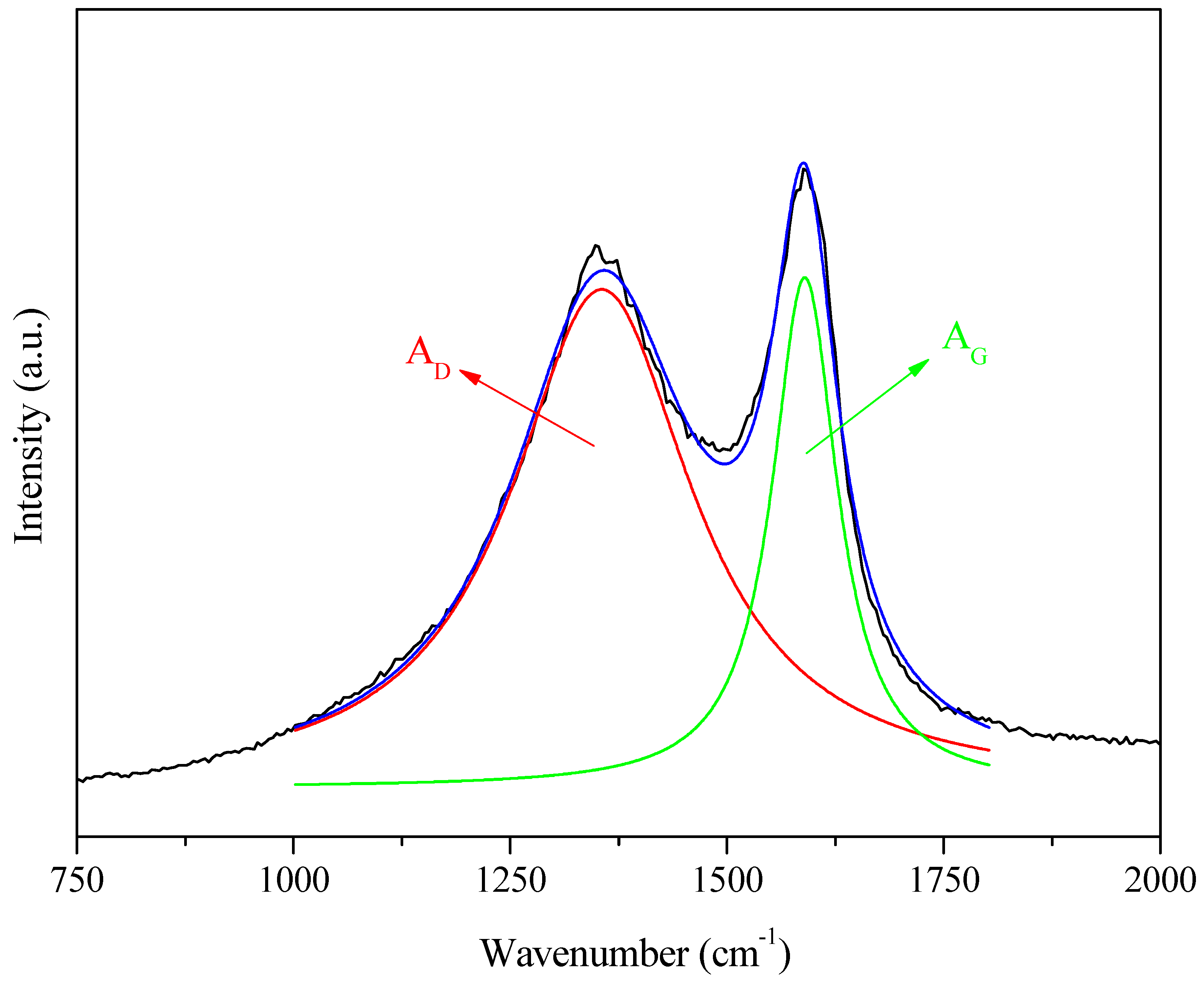
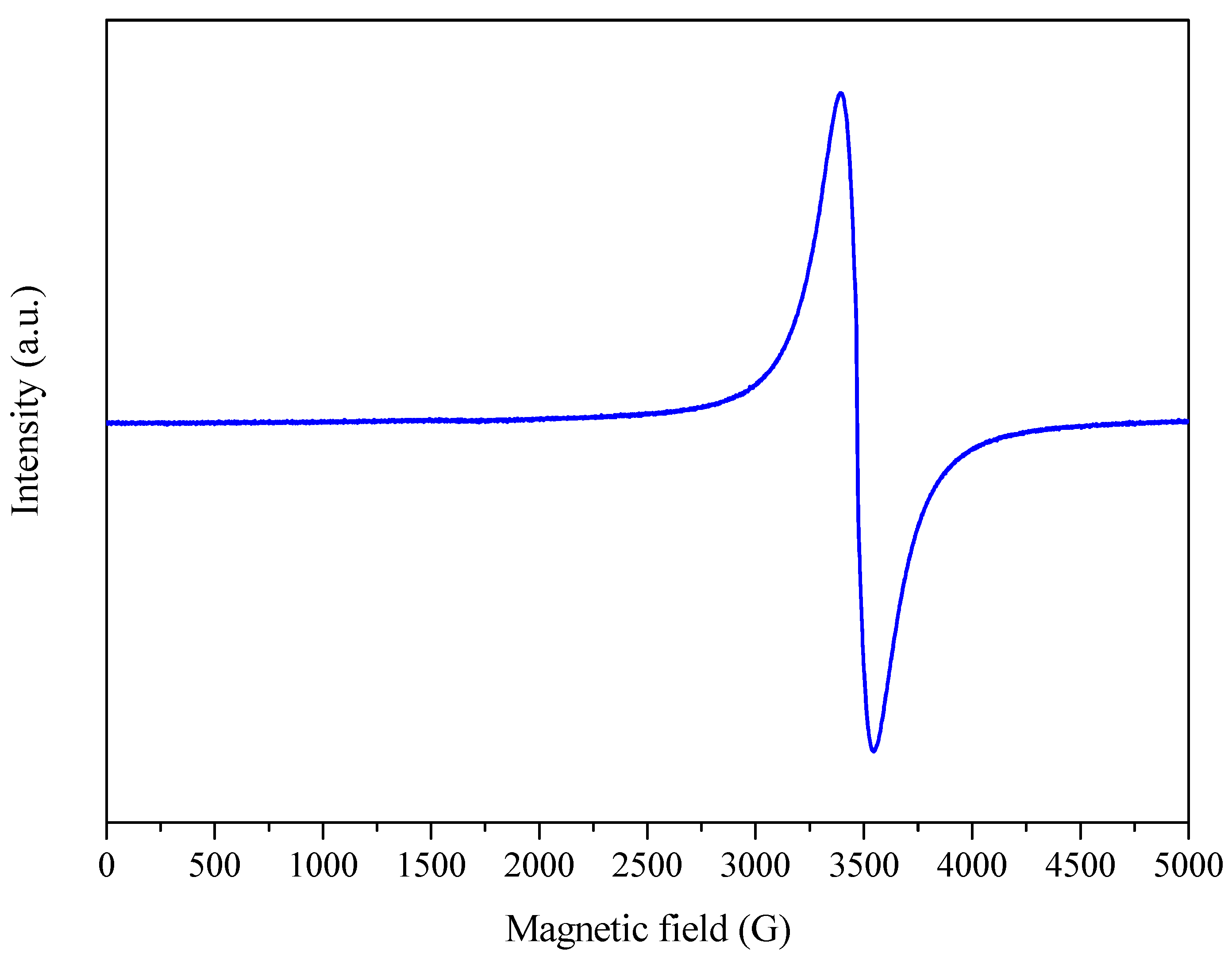
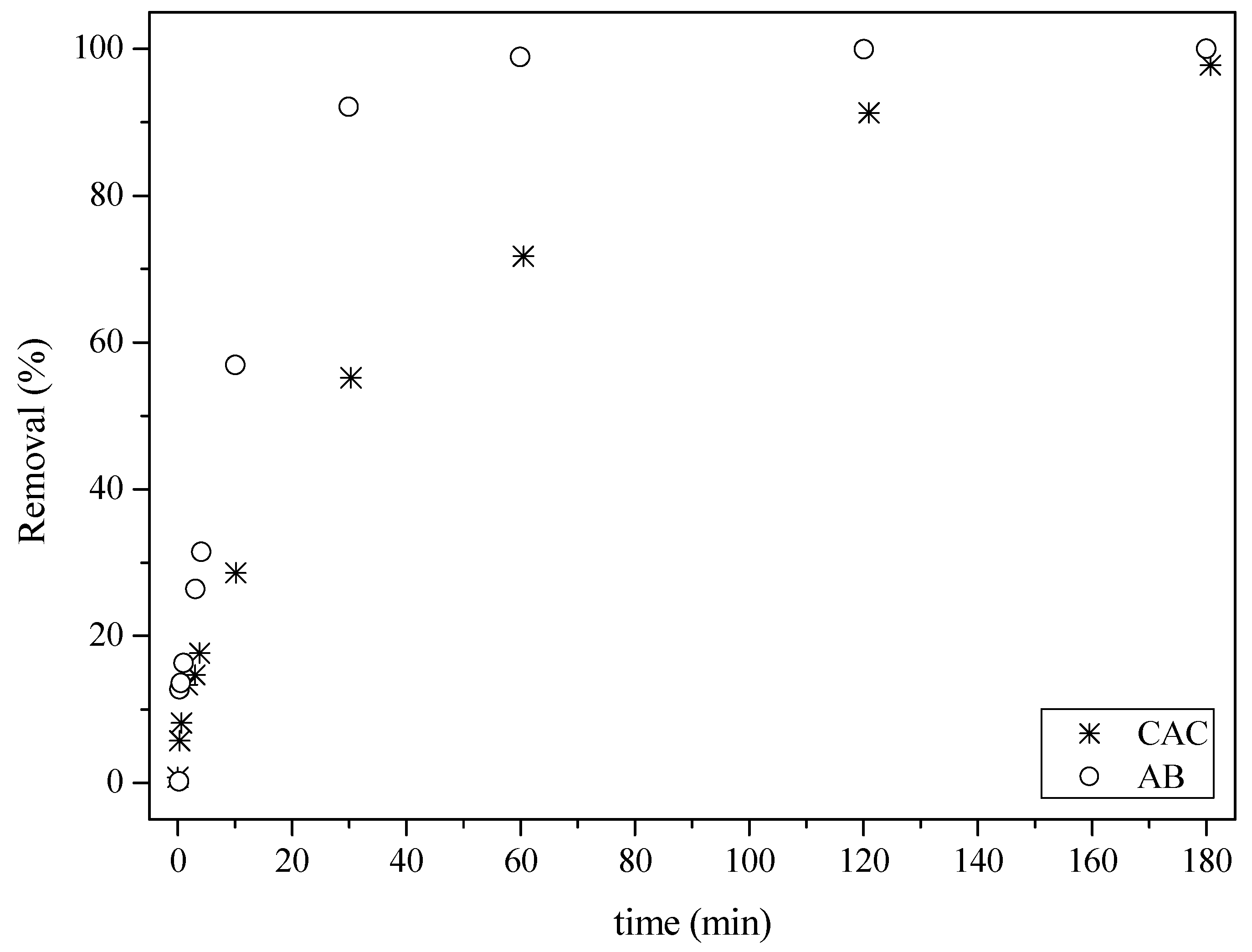
| Factor | Code | Low (−1) | High (+1) |
|---|---|---|---|
| Impregnation time (h) | A | 6.5 | 13 |
| Final carbonization temperature (°C) | B | 400 | 600 |
| Heating rate (°C min−1) | C | 5 | 10 |
| Run | D Band (cm−1) | G Band (cm−1) | (cm−1) | (cm−1) | |
|---|---|---|---|---|---|
| 3 | 1355.6 | 1589.8 | 2.7 | 256.0 | 92.4 |
| 5 | 1365.1 | 1591.5 | 2.8 | 317.2 | 86.1 |
| 6 | 1361.2 | 1586.3 | 2.9 | 304.0 | 98.5 |
| 7 | 1356.3 | 1590.4 | 3.2 | 288.1 | 94.2 |
Disclaimer/Publisher’s Note: The statements, opinions and data contained in all publications are solely those of the individual author(s) and contributor(s) and not of MDPI and/or the editor(s). MDPI and/or the editor(s) disclaim responsibility for any injury to people or property resulting from any ideas, methods, instructions or products referred to in the content. |
© 2024 by the authors. Licensee MDPI, Basel, Switzerland. This article is an open access article distributed under the terms and conditions of the Creative Commons Attribution (CC BY) license (https://creativecommons.org/licenses/by/4.0/).
Share and Cite
Schultz, J.; Leal, T.W.; Pantano, G.; Batista, E.M.C.C.; Matos, T.T.S.; Munaretto, L.S.; de Andrade, J.B.; Mangrich, A.S. Tannin Industry Waste-Derived Porous Carbon: An Effective Adsorbent from Black Wattle Bark for Organic Pollutant Removal. Sustainability 2024, 16, 601. https://doi.org/10.3390/su16020601
Schultz J, Leal TW, Pantano G, Batista EMCC, Matos TTS, Munaretto LS, de Andrade JB, Mangrich AS. Tannin Industry Waste-Derived Porous Carbon: An Effective Adsorbent from Black Wattle Bark for Organic Pollutant Removal. Sustainability. 2024; 16(2):601. https://doi.org/10.3390/su16020601
Chicago/Turabian StyleSchultz, Juliana, Tarcisio Wolff Leal, Gláucia Pantano, Estela M. C. C. Batista, Tassya T. S. Matos, Laiéli S. Munaretto, Jailson B. de Andrade, and Antonio S. Mangrich. 2024. "Tannin Industry Waste-Derived Porous Carbon: An Effective Adsorbent from Black Wattle Bark for Organic Pollutant Removal" Sustainability 16, no. 2: 601. https://doi.org/10.3390/su16020601
APA StyleSchultz, J., Leal, T. W., Pantano, G., Batista, E. M. C. C., Matos, T. T. S., Munaretto, L. S., de Andrade, J. B., & Mangrich, A. S. (2024). Tannin Industry Waste-Derived Porous Carbon: An Effective Adsorbent from Black Wattle Bark for Organic Pollutant Removal. Sustainability, 16(2), 601. https://doi.org/10.3390/su16020601







